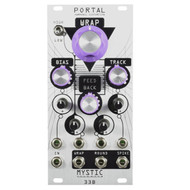Mystic Circuits - Portal
by Andy Simmons
This seems to be the year for distortion, as a lot of awesome stuff has come out already. I have personally been waiting for harmonic stuff for a while, and so my attention was grabbed with Mystic Circuits new module, Portal.
Portal combines harmonics with distortion, as well as pseudo wave shaping. According to the Mystic Circuits website, Portal wraps the input signal around itself up to 50 times, multiplying the harmonics of the signal it’s being fed. You can give it a triangle or a sawtooth to simulate oscillator sync, but they say you don’t need a modulating oscillator to achieve the sync effect. They also say that complex sources will scream like they are from another dimension. This is absolutely true.
Portal sports four big, easy to turn knobs in Mystic Circuits signature purple and silver aesthetic. Wrap controls the harmonic multiplication and when its corresponding LED is blue, that means the output voltage has hit the upper wrap threshold; when it’s red, the voltage has hit the lower wrap threshold. When you use the bias control to push the output into the lower or upper voltage rail, the LEDs will glow brighter than normal to indicate this. There is also a high/low switch, which sets the overall Wrap range. Bias adds a DC offset, Feedback controls feedback amount, and Track controls how well the wrap effect follows the signal. All parameters have attenuator/attenuverter CV inputs except for Bias, which has only an attenuverter CV input. The attenuator/attenuverter knobs makes it so one can precisely mix in how much of the modulation is coming through, a nice feature to have on board. There is a trimpot on the back of the module for the Track CV, and turning this control clockwise will increase the dead zone size but limit the overall range of the parameter. Turning it counter-clockwise will decrease the dead zone size but also decrease the useful range of the knob.
Portal sports three outputs: Wrap, which is the main output of the effect and offers an approximation of a modulo function achieved with analog circuitry. This means that once the input signal hits a certain threshold voltage, the output signal will be reset back to 0. The Round output performs an integer division operation on the input, and Spike, which sends a trigger signal every time a new wrap happens.
I wanted to really push my sound so I decided to throw Portal’s output through more distortion. It’s a lot of fun, and it gets pretty intense at times, which is expected if you distort a distortion. I also flipped it through a distorted signal through the Portal. It got more interesting, but due to the nature of a signal wrapping feedback machine with adjustable tracking, it obliterated lows while adding awesome harmonics and cool dynamics, but is not bass friendly when it really winds up. I found myself either keeping it alone, or having it mid chain to add to it. Additive synthesis with EQ and a nice wet/dry blend really open up another tier of effect, depth, and tone shaping.
I found that the harmonics effect when the toggle is in high mode and coming out of the Round output, overwhelms bass frequencies when in full force. Using an Erica Synths Plasma Drive to process the signal not only softened the harmonics, but with both tracking oscillators on, gave the sound a much more spacious—though aggressive—feel. To take it one step further, I modulated the dry/wet of the Plasma Drive resulting in a very complex dynamic of the softened harmonics of the original signal.
Modulating Portal’s Bias and Track parameters with a complex, chaotic source was extremely gratifying and offered some FM style control of the module. When simultaneously manipulating the input signal and the modulating source, I found Portal’s harmonics effect almost fighting the input signal, and using complex, chaotic sources only amplified this disorienting, harmonics filled, whirlwind of sound.
For those of you who like to make a massive amount of noise, Portal can fill that need. I took all three outputs and sent them out to different distortions to create as much dynamics as I could. One of my favorite tricks is to put a signal into the BASTL Dark Matter and use the Feedback out to do another chain. After routing the patch and with a little panning, I created a wall of sound with just enough variance from the different outputs to create a really devastating soundscape with a lot of subtle shifting. Adding delay and stereo DSP proved to be a fantastic journey into what I’m coining “Harsh Noise Psychedelia.”The harmonics added to a screaming Trogotronic 669, made it surreal and aggressive, and became even more intense when I sent that through a ping pong delay and an interesting reverb.
I love Portal. It’s a very unique and different take on distortion, wavefolding and harmonics and I highly recommend it, even if making way too much noise [is there such a thing?] isn’t your thing.
12 HP
Price: $295


